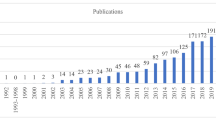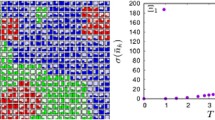Abstract
We present a computer model of opinion changes in a scientific community. The study takes into account two mechanisms of opinion formation for individual scientists: influence of coworkers with whom there is direct interaction and cumulative influence of the subject literature. We analyze the evolution of relative popularity of different competing theories, depending on their accuracy in describing observed phenomena and on current social support of the theory. We include such aspects as finite lifetime of publication impact and tendency to ‘defend’ one’s own opinions, especially if they were already published. A special class of publications, delivering crucial observational or experimental data, which may revolutionize the scientific worldview is considered. The goal of the model is to discover which conditions lead to quick domination of one theory over others, or, conversely, in which situations one may expect several explanations to co-exist.




Similar content being viewed by others
References
Ackermann, E. (2006). Indicators of failed information epidemics in the scientific journal literature: A publication analysis of Polywater and Cold Nuclear Fusion. Scientometrics, 66(3), 451–466.
Anderegg, W. R. L., Prall, J. W., Harold, J., & Schneider, S. H. (2010). Expert credibility in climate change. Proceedings of the National Academy of Sciences, 107(27), 12,107–12,109.
Aspect, A., Grangier, P., & Roger, G. (1981). Experimental tests of realistic local theories via Bell’s theorem. Physical Review Letters, 47, 460–463.
Aspect, A., Grangier, P., & Roger, G. (1982). Experimental realization of Einstein-Podolsky-Rosen-Bohm Gedanken experiment: A new violation of Bell’s inequalities. Physical Review Letters, 49, 91–94.
Barabási, A. L., & Albert, R. (1999). Emergence of scaling in random networks. Science, 286(5439), 509–512.
Bell, J. S. (1964). On the Einstein-Podolsky-Rosen paradox. Physics, 1, 195–200.
Bettencourt, L. M. A., Cintrón-Arias, A., Kaiser, D. I., & Castillo-Chávez, C. (2006). The power of a good idea: Quantitative modeling of the spread of ideas from epidemiological models. Physica A Statistical Mechanics and its Applications, 364, 513–536.
Börner, K., Maru, J., & Goldstone, R. (2004). The simultaneous evolution of author and paper networks. Proceedings of the National Academy of Sciences of the United States of America, 101(Suppl 1), 5266.
Brannon, L., Tagler, M., & Eagly, A. (2007). The moderating role of attitude strength in selective exposure to information. Journal of Experimental Social Psychology, 43(4), 611–617.
Bruckner, E., Ebeling, W., & Scharnhorst, A. (1990). The application of evolution models in scientometrics. Scientometrics, 18(1), 21–41.
Cantú, A., & Ausloos, M. (2009). Organizational and dynamical aspects of a small network with two distinct communities: Neo-creationists vs. evolution defenders. Scientometrics, 80(2), 457–472.
Carroll, S. M. (2004). Why is the universe accelerating? In W. L. Freedman (Ed.), Measuring and modeling the universe. Carnegie Observatories Astrophysics Series (Vol. 2, p. 235). Cambridge: Cambridge University Press.
Castellano, C., Fortunato, S., & Loreto, V. (2009). Statistical physics of social dynamics. Reviews of Modern Physics, 81, 591–646.
Clauser, J. F., Horne, M. A., Shimony, A., & Holt, R. A. (1969). Proposed experiment to test local hidden-variable theories. Physical Review Letters, 23, 880–884.
Deffuant, G., Neau, D., Amblard, F., & Weisbuch, G. (2000). Mixing beliefs among interacting agents. Advances in Complex Systems, 3, 87–98.
Dufour, C., & Tabah, A. (1998). Information epidemics and the transformation of science. In CAIS/ACSI’98: Information science at the dawn of the next millennium. Proceedings of the 26th annual conference of the Canadian Association for Information Science, Association canadienne des sciences de l’information, 3–5 June 1998 (p. 143). Ottawa, ON: Universite d’Ottawa.
Einstein, A. (1917). Kosmologische Betrachtungen zur allgemeinen Relativitätstheorie. Sitzungsber Preuss Akad Wiss (pp. 142–152).
Einstein, A. (1931). Zum kosmologischen Problem der allgemeinen Relativitätstheorie. Sitzungsber Preuss Akad Wiss (pp. 235–237).
Einstein, A., Podolsky, B., & Rosen, N. (1935). Can quantum mechanical description of physical reality be considered complete? Physical Review, 47, 777–780.
Elga, A. (2007). Reflection and disagreement. Noûs, 41(3), 478–502.
Freire, O., Jr. (2004). The historical roots of “foundations of quantum physics” as a field of research (1950–1970). Foundations of Physics, 34(11), 1741–1760.
Freire, O., Jr. (2006). Philosophy enters the optics laboratory: Bell’s theorem and its first experimental tests (1965–1982). Studies in History and Philosophy of Science Part B: Studies in History and Philosophy of Modern Physics, 37(4), 577–616.
Galam, S. (2008). Sociophysics: A review of Galam models. International Journal of Modern Physics C, 19(3), 409–440. http://arxiv.org/pdf/0803.1800.
Galam, S., Gefen, Y., & Shapir, Y. (1982). Sociophysics: A new approach of sociological collective behaviour. I. Mean-behaviour description of a strike. Journal of Mathematical Sociology, 9, 1–13.
Gilbert, N. (1997). A simulation of the structure of academic science. Sociological Research Online, 2(2). http://socresonline.org.uk/2/2/3.html.
Goffman, W. (1966). Mathematical approach to the spread of scientific ideas—the history of mast cell research. Nature, 212(5061), 449–452.
Goldman, A. (2001). Experts: Which ones should you trust? Philosophy and Phenomenological Research, 63(1), 85–110.
Hołyst, J., Kacperski, K., & Schweitzer, F. (2001). Social impact models of opinion dynamics. Annual Review of Computational Physics, 20, 531–535.
Huntington, P., Nicholas, D., Jamali, H., & Tenopir, C. (2006). Article decay in the digital environment: An analysis of usage of OhioLINK by date of publication, employing deep log methods. Journal of the American Society for Information Science and Technology, 57(13), 1840–1851.
Kacperski, K., & Hołyst, J. (1999). Opinion formation model with strong leader and external impact: A mean field approach. Physica A, 269, 511–526.
Kacperski, K., & Hołyst, J. (2000). Phase transitions as a persistent feature of groups with leaders in models of opinion formation. Physica A, 287, 631–643.
Knobloch-Westerwick, S., & Meng, J. (2009). Looking the other way: Selective exposure to attitude-consistent and counterattitudinal political information. Communication Research, 36(3), 426–448.
Kochen, M., & Blaivas, A. (1981). A model for the growth of mathematical specialties. Scientometrics, 3(4), 265–273.
Kuhn, T. S. (1962). The structure of scientific revolutions. Chicago: University of Chicago Press.
Laloë, F. (2001). Do we really understand quantum mechanics? Strange correlations, paradoxes, and theorems . American Journal of Physics, 69, 655–701.
Lee, S., & Bozeman, B. (2005). The impact of research collaboration on scientific productivity. Social Studies of Science, 35(5), 673.
Lewenstein, M., Nowak A., & Latané, B. (1992). Statistical mechanics of social impact. Physical Review A, 45, 763–776.
Lotka, A. (1926). The frequency distribution of scientific productivity. Journal of Washington Academy Sciences, 16, 317–323.
Martins, A. C. R. (2010). Modeling scientific agents for a better science. Advances in Complex Systems (ACS), 13(04), 519–533.
Martinson, B., Anderson, M., & De Vries, R. (2005). Scientists behaving badly. Nature, 435(7043), 737–738.
Menskii, M. B. (2000). Quantum mechanics: New experiments, new applications, and new formulations of old questions. Uspekhi Fizicheskikh Nauk, 43, 585–600.
Newman, M., & Park, J. (2003). Why social networks are different from other types of networks. Physical Review E, 68(3), 36,122.
Newman, M. E. J. (2001a). Scientific collaboration networks. I. Network construction and fundamental results. Physical Review E, 64(1), 016,131
Newman, M. E. J. (2001b). The structure of scientific collaboration networks. Proceedings of the National Academy of Sciences of the United States of America, 98, 5955–5956.
Nicholas, D., Huntington, P., Dobrowolski, T., Rowlands, I., Jamali, H. R., & Polydoratou, P. (2005). Revisiting ‘obsolescence’ and journal article ‘decay’ through usage data: An analysis of digital journal use by year of publication. Information Processing and Management, 41(6), 1441–1461.
Nowak, A., & Lewenstein, M. (1996). Modeling social change with cellular automata. In R. Hegselmann, U. Mueller, & K. G. Troitzsch (Eds.), Modelling and simulation in the social sciences from a philosophy of science point of view (pp. 249–285). Dordrecht: Kluwer.
Perlmutter, S., Aldering, G., Deustua, S., Fabbro, S., Goldhaber, G., Groom, D. E., et al. (1997). Cosmology from type IA supernovae: Measurements, calibration techniques, and implications. Bulletin of the American Astronomical Society, 29, 1351.
Pigliucci, M., & Kaplan, J. (2000). The fall and rise of Dr Pangloss: Adaptationism and the Spandrels paper 20 years later. Trends in Ecology and Evolution, 15, 66–70.
Riess, A. G., Filippenko, A. V., Challis, P., Clocchiatti, A., Diercks, A., Garnavich, P. M., et al. (1998). Observational evidence from supernovae for an accelerating universe and a cosmological constant. The Astronomical Journal, 116, 1009–1038.
Simkin, M. V., & Roychowdhury, V. P. (2003). Read before you cite. Complex Systems, 14, 269–274.
Simkin, M. V., & Roychowdhury, V. P. (2005a). Copied citations create renowned papers? Annals of Improbable Research, 11(1), 24–27.
Simkin, M. V., & Roychowdhury, V. P. (2005b). Stochastic modeling of citation slips. Scientometrics, 62(3), 367–384.
Simkin, M. V., & Roychowdhury, V. P. (2006). An introduction to the theory of citing. Significance, 3, 179–181.
Smolin, L. (2006). The trouble with physics: The rise of string theory, the fall of science and what comes next. London: Penguin Books Ltd.
Sobkowicz, P. (2009). Studies of opinion stability for small dynamic networks with opportunistic agents. International Journal of Modern Physics C (IJMPC), 20(10), 1645–1662.
Sobkowicz, P. (2010). Effect of leader’s strategy on opinion formation in networked societies with local interactions. International Journal of Modern Physics C (IJMPC), 21(6), 839–852.
Sterman, J. D. (1985). The growth of knowledge: Testing a theory of scientific revolutions with a formal model. Technological Forecasting and Social Change, 28(2), 93–122.
Sutton, A., Duval, S., Tweedie, R., Abrams, K., & Jones, D. (2000). Empirical assessment of effect of publication bias on meta-analyses. British Medical Journal, 320(7249), 1574.
Sznajd-Weron, K., & Sznajd, J. (2000). Opinion evolution in closed community. International Journal of Modern Physics C, 11, 1157–1166.
Tabah, A. (1996). Information epidemics and the growth of physics. PhD thesis, Graduate School of Library and Information Studies, McGill University, Montreal, Canada.
Thurner, S., & Hanel, R. (2010). Peer-review in a world with rational scientists: Toward selection of the average. Arxiv preprint arXiv:10084324. http://arxiv.org/pdf/1008.4324.
Wiltshire, D. L. (2008a). Cosmological equivalence principle and the weak-field limit. Physical Review D, 78, 084,032.
Wiltshire, D. L. (2008b). Gravitational energy and cosmic acceleration. International Journal of Modern Physics D, 17, 641.
Zeilinger, A. (1999). A foundational principle for quantum mechanics. Foundations of Physics, 29, 631.
Author information
Authors and Affiliations
Corresponding author
Rights and permissions
About this article
Cite this article
Sobkowicz, P. Simulations of opinion changes in scientific communities. Scientometrics 87, 233–250 (2011). https://doi.org/10.1007/s11192-011-0339-4
Received:
Published:
Issue Date:
DOI: https://doi.org/10.1007/s11192-011-0339-4




